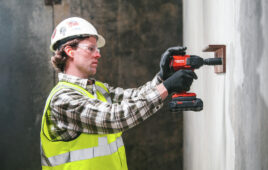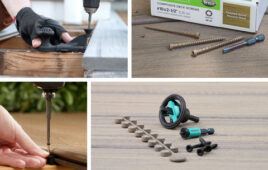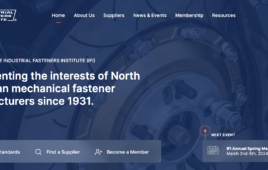Additive manufacturing or 3D printing — the process of building an object one layer at a time based on a digital file — has evolved significantly since the inception in the early ‘80s, particularly in terms of cost and capabilities.

Industrial 3D printing services offer a streamlined and efficient method to reduce the development times of certain parts and simplify supply chains. (Image: Würth)
“Additive manufacturing is a bit of a generic term,” shares Mikhail Gladkikh, Ph.D., technology & operations leader, with Baker Hughes’ Formyst – Additive Manufacturing Services division. “For example, one of the most popular additive processes for plastics is called fused deposition modeling or FDM. And you can think of it like adding icing decoration to the top of a cake, where you’re extruding the icing through a device to form a certain design or shape.”
It’s somewhat analogous to adding flower designs to the top of a wedding cake.
“There are multiple methods of additive with a variety of materials but it’s the process of building a shape or object layer by layer — which is unlike the traditional subtractive methods that remove material until an ideal shape is formed,” he adds.
FDM is one of the most extensively used techniques, where thermoplastic materials are extruded through a nozzle tip (much like icing) and then solidify. It’s ideal for plastics. But additive manufacturing offers several processes that allow for different materials to build objects, such as resins, ceramics, and metals.
“With metal, the most popular process is called powder bed fusion or PBF, which is a welding process that’s been adopted to build shapes. It involves a powdered metal material that’s laid out on a build blade, then you selectively melt certain areas with a laser, and deposit the next layer,” says Gladkikh. Essentially, the PBF process uses a thermal source to induce fusion between metal powder particles, one layer at a time.
Aside from advancements in the materials and equipment used for 3D printing, the processes that relate indirectly to this form of manufacturing are also improving — such as the use of heat treatment.
“Similar to any other metal-working procedures, there are certain post-processing mechanisms for stress relief and improving material properties so they are now similar to or often better than traditional manufacturing,” he says.
Another notable improvement in additive manufacturing relates to reliability, particularly for engineers and manufacturers. Where once a printed part might have only been strong enough for use as a prototype or model, with the proper equipment that part is now durable and consistent enough to be used with the final application.
“When you think of using this equipment in an industrial setting to ‘print’ and replace everyday parts or tools, previously failure was a big concern,” explains AJ Strandquist, director of 3D product solutions with Würth Industry North America. “You just cannot fail six out of 10 times and continue to rely on that process. But that’s no longer the case if you’re choosing the ideal materials and taking care of your equipment correctly.”

An engineer hard at work, reviewing an additive manufacturing project. (Image: Würth)
Gladkikh agrees. “The mechanical properties you can achieve with these processes are now very comparable to traditional methods and, for instance, are often better than metal castings.”
Würth Industry North America and Baker Hughes have recently partnered to offer customized 3D printing services to customers in a range of industrial sectors, offering a new level of scale and automation to customers’ supply chains.
“The key here is the industrialization of additive manufacturing, meaning it’s not just for prototypes or enthusiasts anymore,” says Gladkikh. “It’s truly an industrialized process that companies are adopting to enhance their product designs, processes, inventory, and their overall offerings.”
“Of course, this technology should not replace standards nuts, bolts, or washers,” adds Strandquist. “And I say this because we’re often asked if we print fasteners. There are extremely capable machines that can pump those out rapidly and by the thousands. Additive’s sweet spot is with complex geometry. So, maybe it’s a few pairs of exotically shaped washers or a couple of dozen unique brackets that are required. It’s here that it can excel.”
Another sweet spot that additive manufacturing can potentially solve? Product failures.
“Honestly…look for what’s failing or what’s causing you a headache that could be redesigned,” says Strandquist. “The answer could be in eliminating certain fasteners in a part and completely redesigning a stronger one, thanks to additive manufacturing. It’s certainly not the right tool for every job but it can make a major difference for some parts.”
The top items at a manufacturing site that can likely benefit from 3D printing? “The tool crib,” he says. “Several of those parts and fixtures can be printed for more customized tooling and at lower costs while freeing up your skilled machinists.”
Another example: drilling and completion tools — which were done for Baker Hughes’ oil field services. Components for these tools must be optimized for downhole performance to withstand high pressure, temperature, and vibration.
“We had one of these components that consisted of seven different parts, joined and welded together. But the assembly process resulted in reliability issues because every joint is at a failure risk,” says Gladkikh. “This is where additive comes in as it can create those shapes and combine the different parts in the assembly into a single part that’s completely closed from the outside.” The result is a safer, more reliable product.
To determine where additive manufacturing is ideal, it’s important to assess one’s inventory.
Consider parts that are:
- Unreliable or that break easily
- Unique or that have low manufacturing runs
- Designed with multiple attachments parts
- Made of rare or unique materials
“Where we see the biggest advantage is with assessing existing products and asking, ‘what is the form fit and function of that product?’ Consider its optimal shape and where it experiences pressure, stress forces, or if it needs to flow in a certain way. Then ask, ‘How would I make it optimal?’” shares Strandquist.

An additive manufacturing laser metal deposition process for a gas turbine. (Image: Baker Hughes)
With additive manufacturing, there are no constraints within the design (because you can make any shape) so if a product could be optimized or customized in an ideal manner, 3D printing might be the answer.
“The biggest advantage is what we call, ‘complexity for free’ because of additive’s versatility. You can get terrific results with next-to-zero human interaction,” says Gladkikh. “This is why it’s also considered part of the fourth industrial revolution.”
What Gladkikh means by this is that additive manufacturing is not just a technique for rapid or unique product production. It can also transform industrial supply chains.
“Beyond metalworking or production processes, additive can significantly change the way supply chains and businesses work,” he says. “Take the music industry as an example, where now you can make digital copies of songs and listen to or share them, rather than requiring the physical copies of albums. Well, now you can apply this principle to physical objects and spare parts at a manufacturing facility. This changes the way industries can work.”
Baker Hughes has been applying AI or artificial intelligence to support this effort — creating an algorithm that goes through the inventory of different parts and components at a facility to identify those with designs that are suitable for editing. The result can be parts that, ultimately, perform more reliably and cost-effectively.
“We’ve already quantified more than 500 parts that could benefit from additive manufacturing and have been learning a lot during this process,” says Gladkikh.
“We’re typically moving beyond simple parts here and assessing end-use applications or critical parts and inventory,” says Strandquist. “And this is where we want to support and educate companies and organizations so others are aware of this option. We want companies to know what’s possible for their business.
Through a combination of machine learning algorithms, inventory and maintenance records, and production forecasts, it’s possible to select parts that are suitable for additive manufacturing, digitalize those parts, and provide on-demand ordering using an existing Würth VMI program. This can greatly reduce excess or unused inventory, reduce logistical challenges, and allow for more accurate budgeting.
“This fourth industrial revolution, of which additive manufacturing is a part of, is so much larger than product fabrication,” says Gladkikh. “It also offers a digital form of inventory management, which can completely change the supply chain for manufacturers.”





Tell Us What You Think!